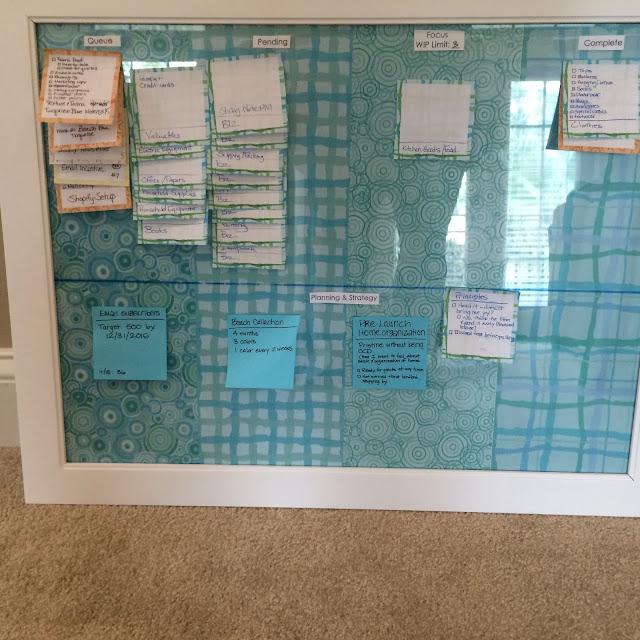Begin Capturing Your Ideas
How do you capture your ideas now? Do you write in your journal? Do you use lists? Do your dreams meander in your mind? Do you use your lists on your smart phone or some other technology?
Capture Your Ideas
It is as simple as a sticky note. Really. (I've managed multi-million dollar corporate projects with stickies!) One of the first important things is to get every single idea you have swimming in your head, captured in lists, written in journals, jotted on napkins...capture everything on a sticky note. For the process of capturing, use plain sticky notes (they're cheaper).
Why a Sticky Note?
There is incredible flexibility with sticky notes. You can move sticky notes around with wild abandon as you collect your ideas. Also, when you change your mind and ideas grow and morph into better ideas, a sticky adapts very easily. If you have a mix of "organized" and "chaos" that works with you, you can still move your sticky notes around with easy adaptation but keep them in neat little lists. The flexibility will be addressed later in the program, but in all my research on tools, I keep coming back to sticky notes as the best tool for flexibility.
Why everything?
Free your mind to focus on the development of the idea. Don't waste time trying to remember your ideas. Write it down. Let it marinate. Let new ideas happen and write them down, too.
“In order for your mind to let go of the lower-level task of trying to hang on to everything, you have to know that you have truly captured everything that might represent something you have to do, and that at some point in the near future you will process and review all of it.” - Getting Things Done: The Art of Stress-Free Productivity, David Allen, Penguin Books, 2001
Go wild! Write everything you can think of. When I finally unleashed my creativity and declared myself an artist, a Creative Mindstorm drenched my mind with ideas. I am still that way only now I capture every idea I possibly can. Create one sticky note per major item. The major exercise right now is “decluttering your brain” and get it out into some tangible form.
What Should I Write Down?
I use this system for everything I need to do: personal/home projects, my art business, sub-projects in my art business, and my day job. So, when I say write everything down, I mean, write everything down.
Keep it High Level, Focus on the End Result, not the Actions
As for the details that you want to capture, this will be expanded on in more detail in future principles of "Tell the Story" and "Plan and Prioritize." But, to save you a little effort, don't write down every single task. This is too much detail for right now We just want to capture high level concepts and high level projects.
Keep it Handy
Keep your sticky notes or at least your journal near you at all times. Write as much as you can. Everything. Little things. Big things. Crazy things. You can toss some of your ideas if you don't like them, but I don't recommend that just yet. Hang on to everything. You never know when a discarded idea might lead to the spark of something great.
Yes, Even Your Crazy Ideas
There is no such thing as a bad idea. When we brainstorm as teams, crazy ideas often spark conversations that light up ideas that are more realistic. Even the crazy idea might be a reality at some point in time, even if there are things that make it less realistic in the here and now. The beauty of keeping things in your head is that no one can make fun of your idea. But, you never know what might happen when you share it. Yes, you might feel a little foolish for putting it out there, but wacky ideas often are the spark for the really, really good ideas.
Where Should You Keep Everything?
Everything is fair game. You can create your own Kanban boards, Kanban project books, or you can find one of the many tools that support the process digitally like Trello, Asana, Rally, or VersionOne. In addition, I have designed fun, coordinated products in my Sticky Note PM collection. You can find a Project Book or Backlog and coordinated Sticky Notes over in my shop.
The Backlog
This collection of ideas you have captured is called a Backlog. If you are familiar with the Agile concepts, you might recognize this term. To be consistent, I use this terminology in this process as well.
The Backlog
This collection of ideas you have captured is called a Backlog. If you are familiar with the Agile concepts, you might recognize this term. To be consistent, I use this terminology in this process as well.
Your Project Book or Project Wall
Collect your ideas in a central location, in a Project Book or Project Wall. It can be a book, a journal, or a piece of wall art. If you create your own book, I recommend heat-laminated pages to make it easier for the notes to stick. (I tried a cold-laminating system and notes just slid off the page.) If you are using a wall system, I recommend putting an attractive poster or wrapping paper into a poster frame under plexiglass or glass. The glass/plexiglass is a good place to adhere the sticky notes.
Next Post - Principle 2: Categorize - group like items together











